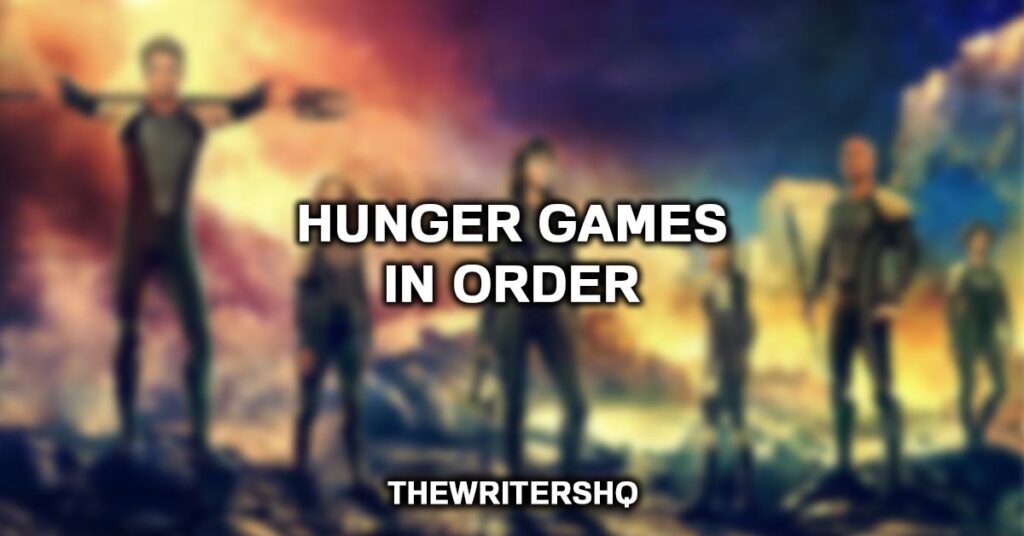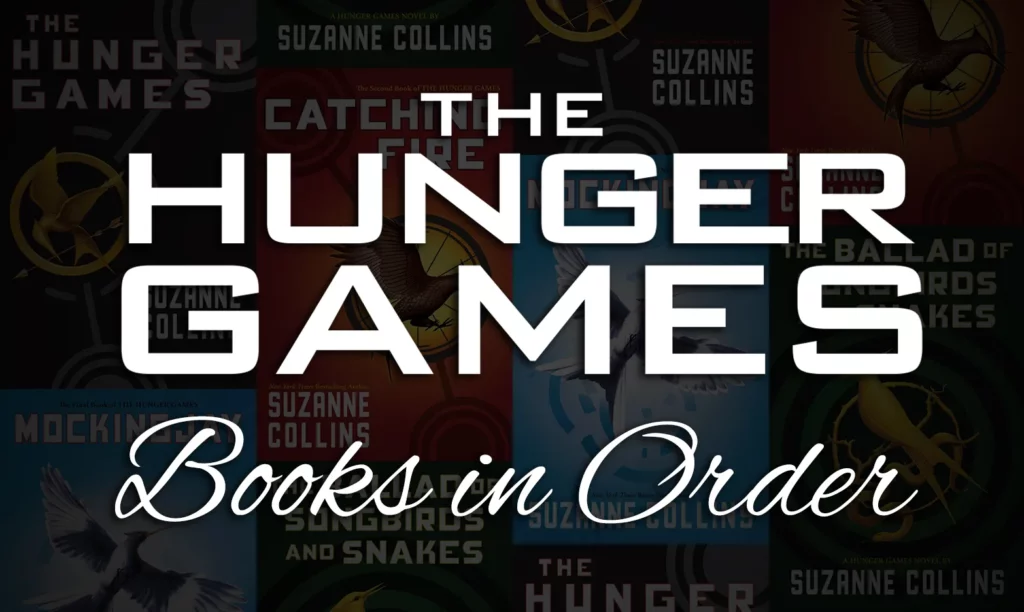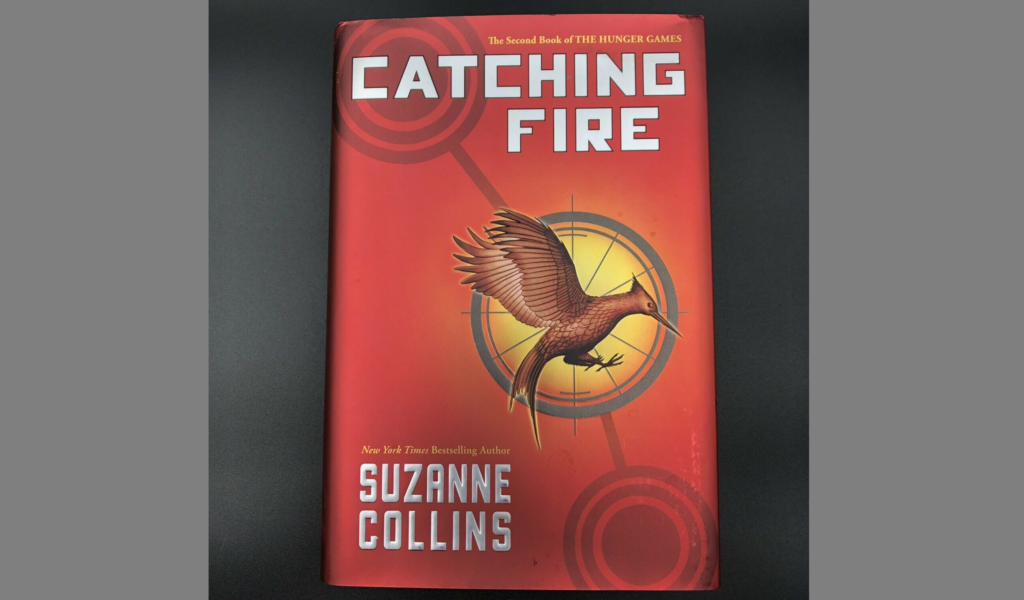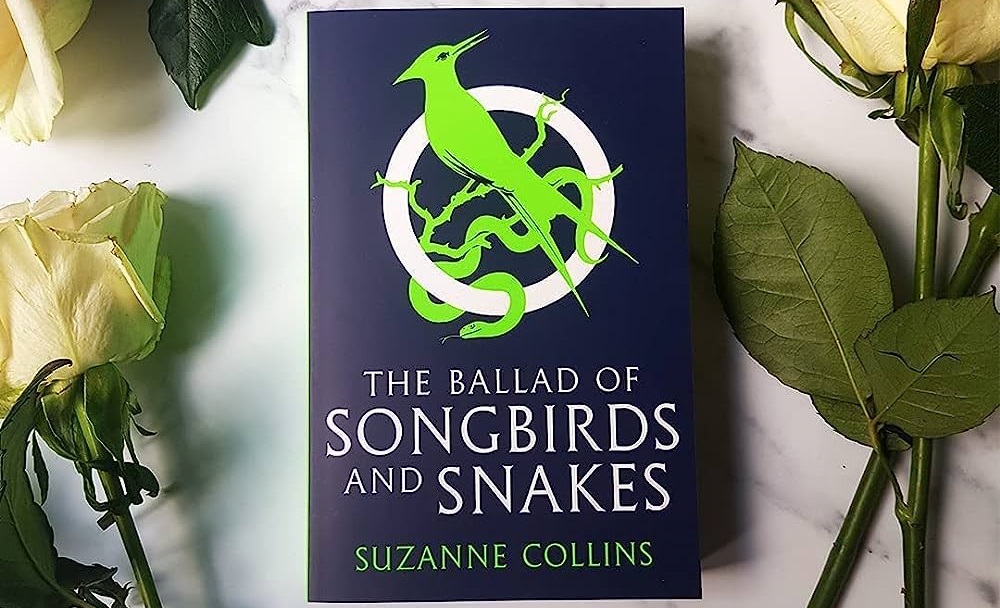For those seeking a thrilling blend of dystopian fiction and action-adventure, the “Hunger Games” series by Suzanne Collins has remained a top pick among readers and film enthusiasts worldwide. Set in a future post-apocalyptic nation called Panem, the series unfolds a chilling narrative about survival, societal control, and rebellion.
This blog post offers a comprehensive guide on how to approach the Hunger Games series, both the books and the films, in chronological order.

The Hunger Games Books In Order

Suzanne Collins’s Hunger Games Trilogy has captivated millions of readers worldwide with its compelling narrative and complex characters. The following is the chronological order of the books:
- “The Hunger Games” (2008): The series starts with the introduction of Katniss Everdeen, a teenager who volunteers to participate in the annual Hunger Games to spare her younger sister, Primrose.
- “Catching Fire” (2009): This sequel delves deeper into the aftermath of the 74th Hunger Games and its impact on the districts, as well as the impending 75th Hunger Games, known as the Quarter Quell.
- “Mockingjay” (2010): The trilogy concludes with the districts of Panem rising in rebellion against the Capitol, and Katniss’s role as the Mockingjay, the symbol of the revolution.
In addition, Collins published a prequel in 2020: - “The Ballad of Songbirds and Snakes” (2020): This prequel to the trilogy takes readers back to the time of the 10th Hunger Games, following the story of a young Coriolanus Snow, who later becomes the tyrannical President of Panem.
The Hunger Games Movies In Order

The Hunger Games series was so successful that it was quickly adapted into a popular movie franchise, captivating a whole new audience with its gripping visuals and performances. Here is the order to watch the movies:
- “The Hunger Games” (2012): Directed by Gary Ross, the film introduces audiences to the dystopian world of Panem and the perilous Hunger Games.
- “The Hunger Games: Catching Fire” (2013): This sequel brings the Quarter Quell to the screen, along with the growing unrest in the districts.
- “The Hunger Games: Mockingjay – Part 1” (2014): The first part of the series finale focuses on Katniss’s role in the rising rebellion and her struggles to rescue Peeta from the Capitol.
- “The Hunger Games: Mockingjay – Part 2” (2015): The final movie concludes the story, showcasing the full-blown rebellion and the overthrow of the Capitol.
Expert Tip: Whether you’re diving into the Hunger Games series for the first time or revisiting it, following the books and movies in order will ensure a captivating journey through the rich narrative crafted by Suzanne Collins.
Do you have to watch The Hunger Games movies in order?
It is highly recommended to watch The Hunger Games movies in order. The films are a sequential adaptation of the book series and each movie builds upon the story of the previous one. If watched out of order, it could lead to confusion and spoil important plot details.
When will The Ballad of Songbirds and Snakes movie premiere?
As of my knowledge cut-off in September 2021, the movie adaptation of “The Ballad of Songbirds and Snakes” was announced, but a specific release date was not yet set. For the most accurate and up-to-date information, you would need to look up the release date online as it may have been announced after my last update.
Are The Hunger Games movies based on a book?
Yes, The Hunger Games movies are based on the book series of the same name by author Suzanne Collins. The series consists of the original trilogy: “The Hunger Games,” “Catching Fire,” and “Mockingjay,” along with the prequel “The Ballad of Songbirds and Snakes” which was released in 2020.
The books were a massive success and were subsequently adapted into a successful film series.
summary of each book
“The Hunger Games” (2008)

Set in the dystopian nation of Panem, the story introduces Katniss Everdeen, a 16-year-old girl living in the impoverished District 12. Each year, the Capitol of Panem forces each of its twelve districts to send a teenage boy and girl, known as “tributes,” to participate in the Hunger Games.
The Games are a televised event where the participants, or “tributes,” are forced to fight to the death in a vast outdoor arena until only one remains. When Katniss’s younger sister Prim is selected as District 12’s female representative, Katniss volunteers to take her place.
She and her male counterpart, Peeta Mellark, are pitted against bigger, stronger representatives, some of whom have trained their whole lives for this.
“Catching Fire” (2009)

After the defiance demonstrated by Katniss and Peeta in the 74th Hunger Games, a rebellion against the brutal Capitol starts to simmer in the districts. President Snow threatens Katniss to suppress the uprising or face the consequences. However, her attempts to put out the fire only ignite it further.
Consequently, in the special 75th Hunger Games, former winners from all the districts are forced to participate in the Games again. This includes Katniss and Peeta, who find themselves back in the arena with alliances forming and the rebellion gaining momentum.
“Mockingjay” (2010)

After the tumultuous end of the 75th Hunger Games, Katniss finds herself in District 13, which was believed to be destroyed during the rebellion years ago but is actually the hub of the revolution against the Capitol. She becomes the symbol, the Mockingjay, of the rebellion.
However, the Capitol still holds Peeta and other tributes captive, manipulating them to quell the rebellion. As the districts unite and war seems imminent, Katniss must decide to save Peeta or focus on the larger battle at hand: to free Panem from President Snow’s tyranny.
“The Ballad of Songbirds and Snakes” (2020)

This prequel takes readers back to the time of the 10th Hunger Games. The protagonist of the book is a young Coriolanus Snow, who is chosen to be a mentor for the Games. Snow, belonging to a once-wealthy but now struggling family, sees this as an opportunity to restore his family’s status in society.
His tribute, Lucy Gray Baird, is an unconventional girl from District 12. The book explores their relationship, the early years of the Hunger Games, and the events that shaped Snow into the future President of Panem.
What themes does Suzanne Collins explore through the Hunger Games series?
Suzanne Collins’s Hunger Games series explores several profound themes. At the core of the series is the theme of survival. From the moment Katniss volunteers for the Hunger Games to save her sister, she’s thrust into a life-or-death struggle. Throughout the series, she continually demonstrates the human instinct to survive even under the direst circumstances.
The series also tackles the theme of power and control, particularly how those in power use fear and manipulation to maintain control. The Capitol, with its annual Hunger Games, is a perfect embodiment of this theme.
The Games are not only a means of punishing the districts for past rebellions but also serve as a tool for the Capitol to exert its power and control and keep the districts in line.
Collins also delves into the theme of sacrifice, reflected in Katniss’s decision to take Prim’s place in the Hunger Games. The sacrifices continue as the series progresses, with characters giving up their safety, comfort, and sometimes their lives for the greater good. The series also touches on themes of identity, rebellion, and the moral complexities of war.
How does the character of Katniss Everdeen develop throughout the series?
Katniss Everdeen, the protagonist, undergoes significant character development throughout the series. In the beginning, she is a resourceful, determined girl, using her hunting skills to provide for her family. But when she volunteers to participate in the Hunger Games, she steps into a larger, more dangerous world.
Her ability to survive the Games not once but twice, and her decision to become the symbol of the rebellion (the Mockingjay), showcases her bravery and resilience.
However, the ordeals she faces leave her dealing with trauma and grief. She battles guilt, nightmares, and the harsh realities of war. By the end of the series, she has changed significantly from the girl she once was, carrying the scars of her experiences, but she also retains her core strength and determination.
What impact did The Hunger Games series have on the genre of young adult dystopian fiction?
The Hunger Games series had a substantial impact on the genre of young adult dystopian fiction. When the first book was released in 2008, it quickly gained popularity due to its unique premise, compelling characters, and the provocative themes it addressed.
Its success not only led to the surge of dystopian fiction in the young adult genre but also set a high standard for the genre itself.
The series proved that young adult books could tackle serious themes and social issues while still delivering an exciting story. It inspired a wave of dystopian novels, such as the Divergent series and The Maze Runner series, that incorporated similar themes of oppressive societies, rebellion, and survival.
How do the Hunger Games movies compare to the books?
The Hunger Games movies stay relatively faithful to the books, capturing the essence of the story, characters, and themes. The casting, particularly Jennifer Lawrence as Katniss, was widely praised for their accurate portrayal of characters. The visuals and special effects brought the world of Panem to life in a way that the books could only describe.
However, like most book-to-film adaptations, some details and scenes were left out or altered for cinematic purposes. Some readers felt that these changes reduced the depth and complexity of the story and characters. But overall, the movies were well-received, especially among those who appreciated seeing Collins’ world come to life on the big screen.
Why is “The Ballad of Songbirds and Snakes” significant in the Hunger Games series?
“The Ballad of Songbirds and Snakes” is significant because it offers a deeper look into the history of Panem and the origins of the Hunger Games. Focusing on a young Coriolanus Snow, it provides insight into the character who would become the primary antagonist of the original trilogy.
It explores how Snow’s experiences, beliefs, and choices shape him into the tyrannical leader he becomes. Additionally, it expands on the world of Panem and its early years, showing a different perspective on the events leading up to the first book.
Quick Fact: The book gives readers a better understanding of the broader political and social contexts within which the events of The Hunger Games take place.
How does the dystopian setting contribute to the story of The Hunger Games?
The dystopian setting is integral to the story of The Hunger Games. The harsh realities of life in Panem, particularly in the districts, create a stark contrast to the extravagant and detached lifestyle of those in the Capitol. This contrast accentuates the inequality and oppression faced by the districts, setting the stage for the struggle and rebellion that unfolds.
The dystopian nature of the setting also heightens the stakes for the characters. Every decision carries weight, and survival often comes at a great cost. It’s this tension and constant danger that keep readers engaged and invested in the characters’ fates.
How does The Hunger Games series conclude and what does it signify?
The Hunger Games series concludes with the overthrow of the Capitol and President Snow’s death. Katniss, despite being put on trial for killing President Coin, is pardoned and returns to District 12, while Peeta joins her later. They eventually start a family, but the scars of their experiences linger.
The ending signifies the cost of war and the struggle to find hope and healing in its aftermath. It emphasizes that while the tyranny of the Capitol has been overthrown, the damage it inflicted cannot be easily erased. Katniss and Peeta’s decision to have children despite their trauma signifies a cautious hope for a better future, a new beginning after years of hardship.
How does The Hunger Games series use the concept of spectacle?
The concept of spectacle is integral to the entire Hunger Games series. The Hunger Games themselves are a spectacle designed by the Capitol to display its power, keep the districts in check, and provide entertainment for its citizens. The Games are broadcast live throughout Panem, with the tributes treated like celebrities.
This use of spectacle is a commentary on modern society’s obsession with reality TV and how it can be used as a tool for manipulation and control. It also emphasizes the dehumanizing effect of turning violence and suffering into a form of entertainment.
In what way does the trilogy challenge societal norms and structures?
The Hunger Games trilogy consistently challenges societal norms and structures, particularly the imbalance of power, wealth, and resources. The Capitol, with its affluent lifestyle, is a stark contrast to the impoverished districts, symbolizing the vast wealth disparity often seen in real societies.
The series underscores the importance of resistance against oppressive systems, portrayed through the rebellion initiated by the districts.
Katniss Everdeen’s character also challenges traditional gender norms. She is depicted as a skilled hunter and fighter, who is also caring and empathetic. Her refusal to conform to the expectations of the Capitol during the Games further disrupts societal norms.
How does the character of Peeta Mellark contrast with Katniss Everdeen?
Peeta Mellark serves as a significant contrast to Katniss Everdeen throughout the series. While Katniss is a hunter, survivor, and naturally rebellious, Peeta is more diplomatic, skilled in speech, and often plays by the rules. His strength lies not in physical prowess but in his ability to appeal to the public and sway their emotions.
His love for Katniss is constant and unwavering, providing a softer counterpoint to the harsh realities of their lives.
Despite their differences, Peeta and Katniss complement each other. Katniss’s survival instincts and Peeta’s ability to connect with others create a successful dynamic that helps them survive the Games.
Both characters challenge traditional gender roles Katniss through her resourcefulness and physical strength, and Peeta through his emotional intelligence and nurturing qualities.
What impact does the portrayal of violence have on the narrative of The Hunger Games series?
The portrayal of violence is a significant aspect of the narrative in The Hunger Games series. It serves as a stark reminder of the Capitol’s brutality and the oppressive system under which the districts live. The violence in the Games themselves, especially the fact that it’s being inflicted upon children, highlights the dehumanizing effects of such a spectacle.
The series doesn’t shy away from showcasing the grim consequences of violence, both physical and psychological, on its characters.
However, the violence is not gratuitous; it serves a purpose in the narrative. It underscores the desperate need for change and fuels the drive for rebellion. It also fosters a sense of empathy and solidarity among readers toward the characters and their plight.
What role does the media play in The Hunger Games series?
The media plays a significant role in The Hunger Games series. The Capitol uses the media to control the narrative and manipulate the citizens of Panem. The Hunger Games are broadcast as a lavish spectacle, complete with interviews, betting, and pageantry, masking the brutal reality of the event.
However, the media also becomes a tool for rebellion. Once the uprising begins, the rebels use propos (propaganda films) to rally the districts against the Capitol, with Katniss as the face of the rebellion. This highlights the power of media as a tool for both oppression and resistance.
How is hope portrayed in The Hunger Games series?
Hope is a recurring theme throughout The Hunger Games series. Despite the grim circumstances, the characters continuously cling to hope, whether it’s the hope of surviving the Games, the hope of a successful rebellion, or the hope of a better future. Katniss symbolizes this hope for many characters, including Peeta, her family, and eventually all the districts.
However, the series also explores the danger of hope when manipulated. The Capitol uses the hope of winning the Games to keep the districts in line and perpetuate their oppressive system. This complex portrayal of hope adds depth to the narrative and resonates with readers.
What makes The Hunger Games series a compelling read for both young adults and adults?
The Hunger Games series is a compelling read for both young adults and adults due to its complex characters, engaging plot, and the thought-provoking themes it explores. The series combines elements of adventure, suspense, and romance with deeper social commentary, making it a layered and enriching reading experience.
For young adults, it offers relatable characters who are dealing with identity, love, and societal pressures, albeit in a dystopian setting. For adults, the series provides a critique of power structures, media influence, and societal inequalities. It raises questions about morality, survival, and resistance that provoke introspection and discussion.
Conclusion
The Hunger Games series by Suzanne Collins is a remarkable feat of storytelling that delves deep into the heart of human resilience, power dynamics, and societal issues. Through the lens of a dystopian future, it reflects realities that resonate with our present world, making us question and ponder.
Whether you experience this series through the turning of pages or the magic of the screen, the journey through the districts of Panem is one that captivates and leaves a lasting impact.
As we traverse from the first Hunger Games to the final Mockingjay, we come to realize that the hunger for freedom, justice, and hope is a game that humanity has been playing since time immemorial.
